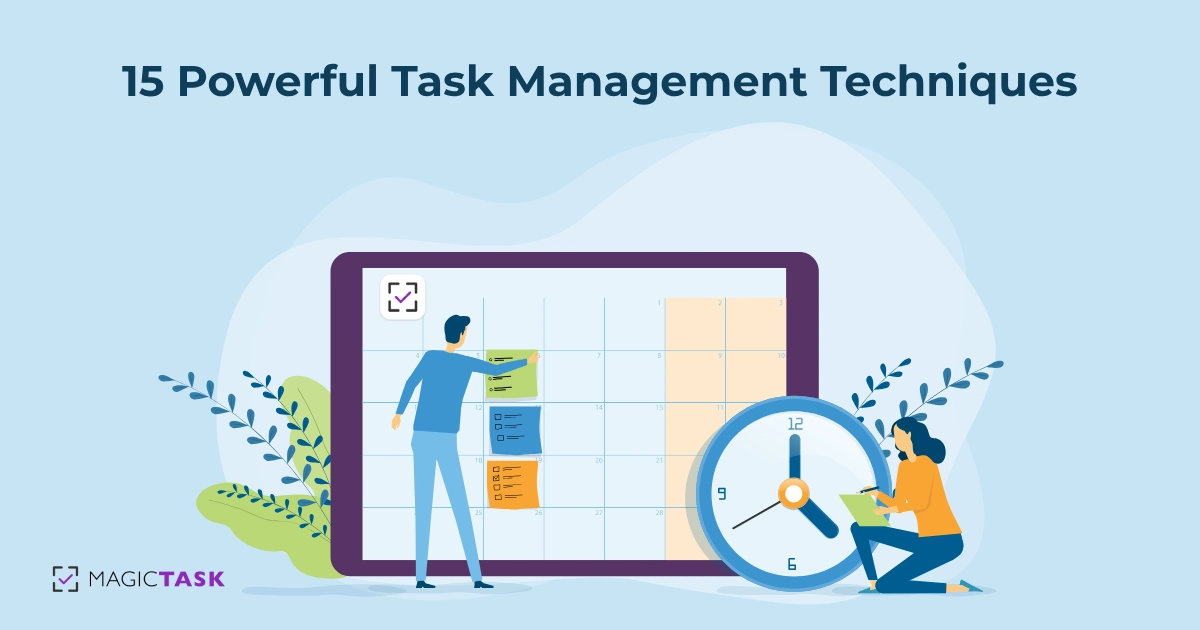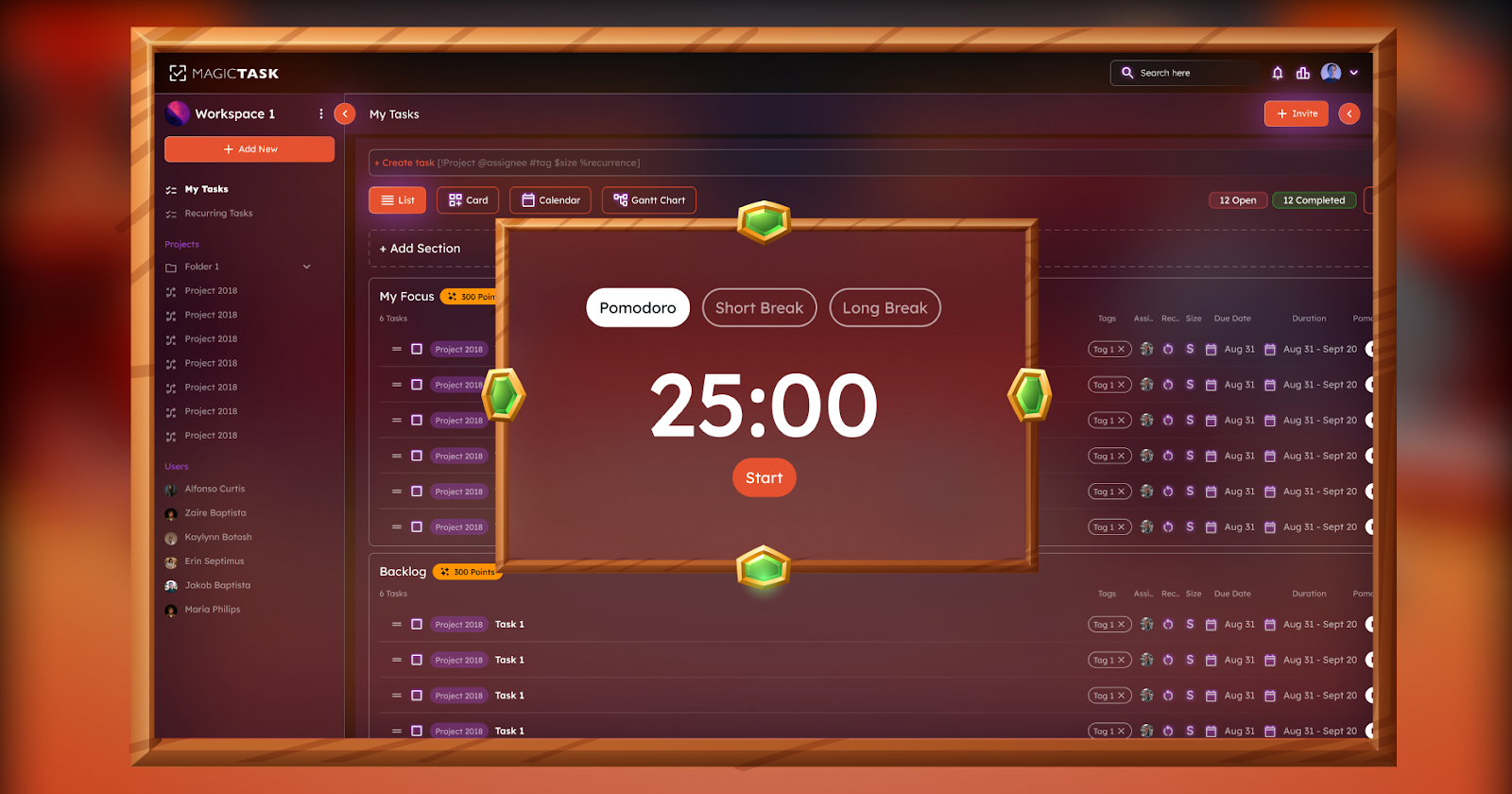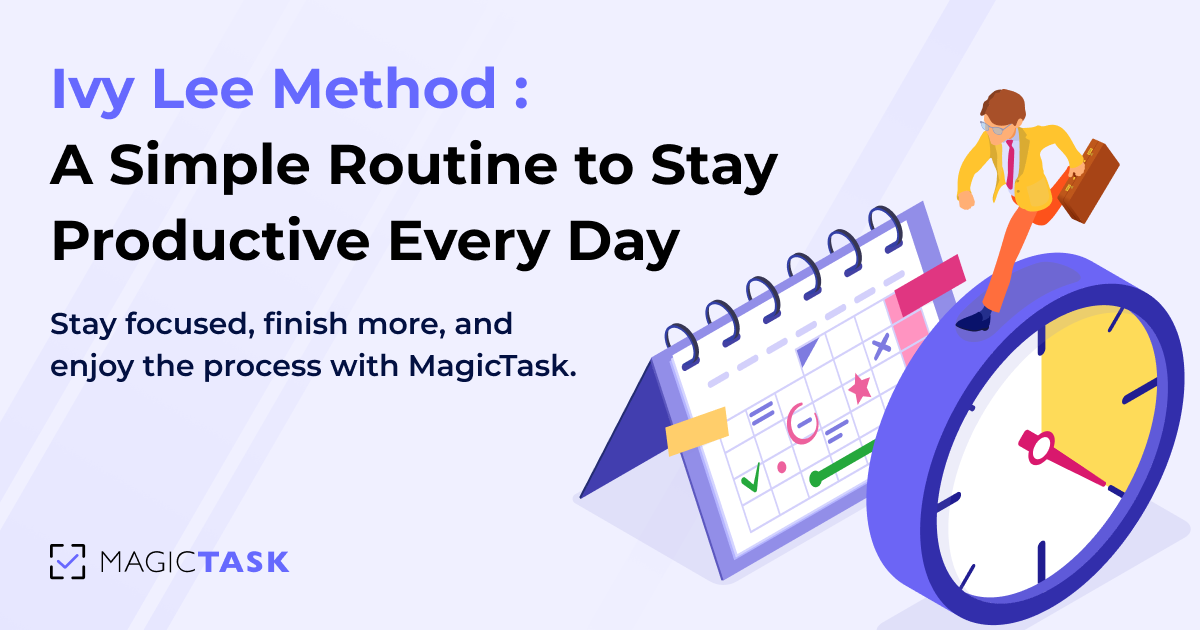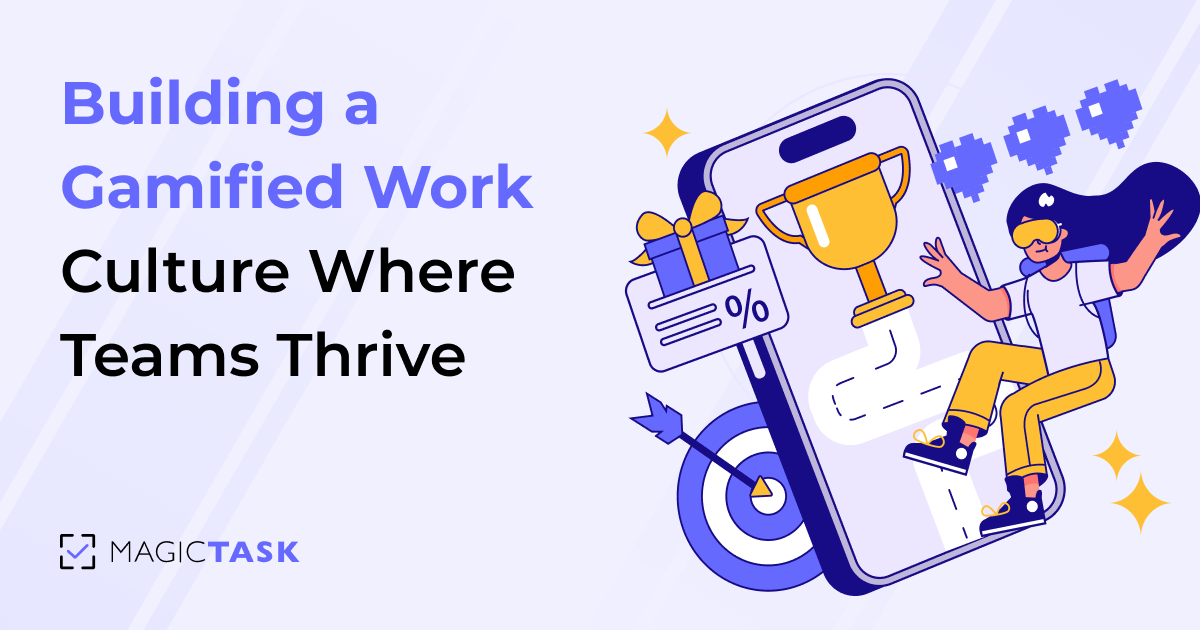15 Powerful Task Management Techniques

Effective task management techniques are essential for anyone aiming to stay organized and productive, whether in personal projects or professional pursuits.
Task management, at its core, is about structuring, prioritizing, and tracking tasks in a way that aligns with specific goals, helping reduce stress and enhance efficiency. Different task management techniques are proven to manage tasks efficiently based on their unique workflow needs.
In this guide, we will explore 15 powerful techniques that can transform how you approach daily tasks and manage complex projects. From prioritizing urgent tasks to breaking down larger goals, these strategies are designed to help you optimize both time and focus, making it easier to achieve more without feeling overwhelmed.
Let's begin!
1. Prioritize Tasks with the Eisenhower Matrix
The Eisenhower Matrix is an effective task management technique. In this method, we prioritize tasks based on urgency and importance. The tasks are organized into four distinct quadrants:
- Urgent and Important: These tasks demand immediate attention and usually have pressing deadlines or significant consequences if delayed. Examples include project delivery deadlines, critical client issues, or health-related emergencies.
- Important but Not Urgent: These tasks are essential for long-term success but can be scheduled for later. Examples might include strategic planning, professional development, or setting personal goals.
- Urgent but Not Important: Tasks in this quadrant are often interruptions that don’t necessarily contribute to long-term goals. For instance, answering non-essential emails, handling minor requests, or attending non-critical meetings.
- Neither Urgent nor Important: These tasks don’t require immediate action and typically don’t impact overall objectives. Examples include unnecessary administrative work, excessive social media scrolling, or sorting through unimportant emails.
By regularly assessing tasks using this matrix, you can maintain focus on what matters most while minimizing time spent on less impactful activities.
2. Break Down Goals Using the SMART Method
The SMART method is a well-established approach for setting clear, actionable goals by focusing on five key attributes:
- Specific: Goals should be precise and clearly defined. For example, instead of a broad aim like “get healthier,” a specific goal would be “exercise three times a week.”
- Measurable: A goal needs to be trackable to assess progress. “Read 12 books this year” is measurable, allowing you to check your pace over time.
- Achievable: Goals should be realistic, given the time and resources available. If you’re new to running, aiming for a marathon next month may not be achievable, but training for a 5K might be.
- Relevant: Each goal should align with your broader ambitions or values. If your focus is career development, a relevant goal might be to “complete a professional certification this quarter.”
- Time-bound: Assigning a timeframe creates urgency and helps prevent procrastination. A time-bound goal could be “finish drafting my article by Friday.”
Breaking down large objectives into SMART goals allows you to take manageable steps, keeping motivation high and progress consistent.
3. Master Time Blocking for Structured Days
Time blocking is a productivity method that involves scheduling specific blocks of time for particular tasks or activities throughout the day.
By dedicating distinct periods to focused work, meetings, and even breaks, time blocking helps eliminate distractions and maintain a structured workflow. This approach allows for a clear day overview, making it easier to stay on track and avoid multitasking.
The advantages of time blocking are numerous. It encourages a deep focus on one task at a time, reducing the mental fatigue of constantly switching between activities. It also makes it easier to set boundaries, allowing for more intentional breaks and preventing work from spilling into personal time.
Modern task management tools integrate with calendars, enabling seamless time blocking. By syncing tasks with your schedule, these tools can streamline time allocation, helping to reinforce boundaries and keep each day well-organized and productive.
4. Embrace the "Two-Minute Rule"
The "Two-Minute Rule" is a simple yet impactful technique designed to handle small tasks immediately rather than letting them pile up.
The rule suggests that if a task takes two minutes or less to complete—whether it’s replying to a quick email, organizing a file, or making a brief call—it’s best to do it immediately. You can prevent these minor tasks from accumulating into a daunting backlog by addressing them as they arise.
Applying the Two-Minute Rule leads to quick wins that can create positive daily momentum. No matter how small, each completed task reduces the mental load and frees up mental space. This makes concentrating on larger, more complex projects easier without the lingering stress of unfinished minor tasks hanging in the background.
5. Apply the Pomodoro Technique for Focus

The Pomodoro Technique is a time management method that breaks work into intervals, traditionally 25 minutes long, followed by a 5-minute break. Developed by Francesco Cirillo in the 1980s, this technique aims to maintain focus and prevent burnout by working in short, focused bursts. After completing four "Pomodoros," or work intervals, a longer break of 15–30 minutes is taken to recharge.
To get the most out of the Pomodoro Technique, try these tips:
- Choose a single task to focus on for each Pomodoro to avoid the distraction of multitasking.
- Set a timer for the 25-minute interval, and commit to working on that one task without interruptions.
- Use the short breaks between intervals to step away from your workspace, stretch, or refresh with a quick walk.
- Evaluate and adjust your tasks at the end of each more extended break, ensuring that your remaining tasks align with your goals for the day.
This technique is effective for those who struggle with focus or feel overwhelmed by large tasks, making it easier to make consistent progress without feeling exhausted.
6. Delegate Tasks Wisely
Delegating tasks is essential for effective time management, especially when managing multiple responsibilities or working within a team.
Knowing when to delegate is vital; tasks that are routine, time-consuming, or can be handled by someone with the right skills are ideal candidates for delegation. This approach lets you focus on higher-priority responsibilities requiring direct involvement or specialized expertise.
When delegating, it’s essential to communicate clearly. Provide a clear brief, outline expectations, and set deadlines. This ensures the person taking on the task has all they need to complete it successfully.
Additionally, regularly check in on progress without micromanaging. Use collaborative tools that make it easy to assign tasks, set deadlines, and monitor progress, helping the delegator and the person taking on the task stay aligned and productive.
By delegating wisely, you can free up time for critical tasks, reduce burnout, and create an environment of shared responsibility.
7. Use Task Batching to Reduce Context Switching
Task batching is a productivity technique in which similar tasks are grouped and completed, minimizing the mental energy wasted switching between unrelated activities. By focusing on one type of task at a time, you can maintain a steady rhythm, improve efficiency, and reduce the stress of multitasking.
For example, designate a specific time block for addressing all emails simultaneously instead of responding to emails sporadically throughout the day. Similarly, if you’re working on content creation, allocate a batch of time to focus solely on writing or editing multiple pieces. This way, your mind remains engaged with similar tasks, allowing you to work more smoothly without the constant disruption of shifting gears.
Task batching is particularly useful for reducing context switching, making it easier to stay focused and accomplish more in less time.
8. Build a Realistic To-Do List
Creating a realistic to-do list is key to managing your workload without feeling overwhelmed. One practical approach is focusing on 3-5 main daily tasks. By narrowing down your daily priorities, you can concentrate on what truly matters without getting bogged down by an overly ambitious list. This approach helps prevent the discouragement that often comes from leaving tasks unfinished.
When building your list, prioritize tasks based on urgency and importance, and be mindful of your time constraints. Choose tasks that align with your main goals for the day, and avoid adding unnecessary items just to fill space. This practice fosters a sense of accomplishment, allowing you to finish each day with tangible progress on essential tasks.
9. Conduct Regular Progress Reviews
Regular progress reviews are essential for aligning your tasks with your long-term goals. Setting aside time each week and month to assess your progress can help you identify what’s working, what needs adjustment, and how to prioritize your upcoming tasks.
Weekly reviews allow you to track short-term achievements and address any obstacles before they become larger issues. On the other hand, monthly reviews give a broader perspective, helping you evaluate whether you’re on track with your goals and whether adjustments are needed in your overall strategy. By consistently checking in on your progress, you can maintain focus, stay accountable to your goals, and make informed decisions that drive you forward.
This habit boosts productivity and ensures that your daily efforts contribute meaningfully to the bigger picture.
10. Minimize Distractions
Creating a distraction-free workspace is key to maintaining focus and productivity. Here are some practical tips to help minimize interruptions:
- Declutter your workspace: A clean, organized space reduces visual distractions and makes it easier to focus on tasks.
- Set boundaries: Communicate with those around you, whether at home or in the office, to let them know your focus hours. Wearing headphones can also signal that you're in a work mode.
- Limit digital distractions: Turn off non-essential notifications on your devices, and consider using apps or browser extensions that block distracting sites while you work.
- Schedule breaks: Allow for short, intentional breaks throughout your day to step away from work and recharge, making it easier to return with renewed focus.
Reducing distractions helps you stay on task and accomplish more in less time, creating a work environment that promotes both focus and productivity.
11. Set Deadlines for Accountability
Setting realistic deadlines is a powerful way to stay motivated and keep tasks on track. When you assign a specific due date to a task, it creates a sense of urgency, making it easier to prioritize and focus on completing it. Deadlines help break down larger projects into manageable steps, each with its timeline, preventing procrastination and ensuring steady progress.
Deadlines also build accountability, especially when paired with reminders that prompt you to stay on schedule. Task management tools simplify this process by allowing you to set due dates, receive reminders, and track the status of each task.
This structure helps you stay organized, boosting both motivation and efficiency by ensuring you’re consistently moving forward.
12. Follow the Pareto Principle (80/20 Rule)
The Pareto Principle, commonly known as the 80/20 Rule, suggests that 80% of outcomes are often the result of just 20% of efforts. In terms of productivity, this means that a small number of high-impact tasks can lead to the majority of your results.
Identifying and focusing on these critical tasks allows you to maximize efficiency and make substantial progress without feeling overwhelmed by less essential activities.
To apply the Pareto Principle effectively, start by evaluating your tasks and asking yourself which ones directly contribute to your primary goals. Prioritize these high-impact tasks, which are likely to drive the most value.
Regularly reassess your workload to ensure you spend most of your time on activities that make a meaningful difference. This approach lets you streamline your efforts, concentrating on what moves the needle.
13. Keep a Task Journal
Maintaining a task journal is an effective way to track progress, celebrate small wins, and identify areas for improvement. By recording daily accomplishments, you create a space to acknowledge your efforts, boosting motivation and providing a sense of achievement, no matter how small the tasks.
A task journal also allows you to observe patterns over time. Noticing which types of tasks you consistently complete and which tend to linger can offer insights into your productivity habits and help you adjust your approach as needed.
By regularly reviewing your entries, you can identify obstacles, refine your workflow, and set realistic goals based on what works best for you. Over time, this journal becomes a personal roadmap to productivity, showing your growth and helping to keep you on track.
14. Use Visual Task Management Boards
Kanban boards are a powerful tool for visualizing progress and managing tasks.
By displaying tasks as cards on a board, typically organized into columns like "To Do," "In Progress," and "Done," Kanban boards offer a clear view of where each task stands in the workflow. This visual approach helps with task prioritization, makes it easy to identify bottlenecks, and keeps your focus on the current tasks without losing sight of what’s completed or upcoming.
The drag-and-drop functionality of modern task management tools makes using Kanban boards even more intuitive. Moving tasks between columns feels natural and allows you to quickly update progress, creating a dynamic system that adapts as priorities shift. This hands-on approach to task management enables a seamless, organized workflow where progress is visible at a glance.
15. Learn to Say No
Learning to say "no" is an essential skill for effective task management. Protecting your time and energy allows you to focus on tasks that align with your goals and priorities, helping you avoid the burnout that often comes from over-commitment.
When you take on too many responsibilities, your productivity and well-being can suffer, making it harder to accomplish what truly matters.
To decline tasks politely, try expressing appreciation for the opportunity and briefly explaining your current commitments.
For example, you might say, “I appreciate you thinking of me for this, but I’m focusing on a few key projects right now.” If appropriate, suggest another person who could help or offer to assist later when your schedule allows. Setting these boundaries with respect and clarity allows you to maintain positive relationships while staying true to your priorities.
Conclusion
Mastering task management can transform how you approach daily tasks and long-term goals. Using these strategies, you can prioritize effectively, stay focused, and progress steadily.
Adding tools like MagicTask can help you fine-tune your task management approach. MagicTask offers the features you need to bring these methods to life, from clean, fast tasks UI to recurrent tasks and themes.
Ready to take control of your productivity? Explore MagicTask and see how it can help you achieve more with less stress.




